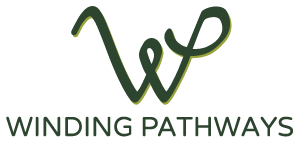by Winding Pathways | Aug 4, 2017 | Nature, Travel/Columns

A picture perfect day to canoe.
On a splendid late July day we packed up food, loaded the canoe, paddles and life jackets and headed out to explore the Odessa Water Trail. It’s one of Iowa’s several water trails and part of a larger system of water trails in the Midwest. What a blast!
Two hours south of Cedar Rapids the The Odessa Trail in Louisa County offers a way to explore backwaters safely. It winds through two wildlife management areas. The map we picked up at the Port Louisa National Wildlife Refuge Headquarters ensured we would not get lost in the maze of channels that form the meandering floodplain. Tucked in the inner elbow below Iowa’s bulge with the “Father of Waters” this refuge, managed for waterfowl and wildlife, encompasses 6400 acres and sports three tails ranging from an easy three mile paddle to a moderate 4.5 mile cruise to a 6.5 trek that can extend to 17 miles!
The Refuge closes from mid-September to January first to accommodate migratory waterfowl. Other times it is open to boaters, canoeists and kayakers, fishermen, and birders. Hiking and bicycling trails line the main islands, but those adventures could be dicey in high water and just plain buggy in hot weather. A campground is conveniently located near the Odessa Wildlife Unit Headquarters.
This day was just right. High pressure kept winds down, the sun was warm, but the air cool, especially for July. Sunscreen, long sleeved shirts and hats kept the sun’s rays at bay. Mid summer is quiet for bird life after their busy nesting season. Still we heard and saw a variety of songbirds and kept annoying a Great Egret and at least two Great Blue Herons. They would nervously watch us approach then with a loud squawk lift off and wing a few hundred yards down stream. Only to be annoyed again, when we approached. We did watch a heron catch and swallow a fish.
Along the banks frogs of all sizes croaked and leapt into the murky water. Lots of fish were rising up, but Rich decided not to wet his line, and rather studied the trail map carefully as we floated and paddled. Partway down, we pulled in for lunch balancing snacks in the canoe as the day drifted by.
It was great to try out one of Iowa’s many water trails. Check out the link to the National Park’s National Water Trail System. And, enjoy the short videos and photo gallery below. Go Outside and Play!
Great Egret Flies Off Click this link to see.
Great Blue Heron fishes.
-
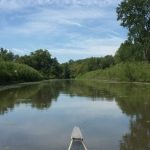
-
Access to the trail is a canal that slows into the Mississippi River.
-

-
Odessa Water Trail is well marked.
-

-
Eyeing us.
-

-
In the shade.
-

-
Tell tale signs
-

-
Great Blue Heron
-

-
Harbinger of changing weather.
-
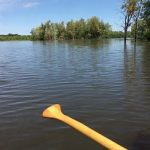
-
Silver Maples beginning to turn.
by Winding Pathways | Jul 27, 2017 | (Sub)Urban Homesteading, Garden/Yard, Mammals, Nature
We like opossums and are always happy to see one shuffling off when we startle it after dark. This amazing animal gets too little respect and appreciation by people who consider them dirty, stupid, and ugly. They are just the opposite!
Opossums are doing something right. They’re survivors who have been on the planet far longer that humans. Often called ‘possums, they were once common only in southern states. Their fur is sparse and doesn’t cover tails or ears, so winter is rough on them. Warming temperatures are helping this animal move north, and they’re now common in Maine, Minnesota and other more northern states where they once were absent.
‘Possums are our only native marsupial. Like kangaroos, female opossums have a pouch to nourish their young. Born after only a 13-day pregnancy tiny babies make their way into her pouch where they remain for about 100 days feeding on mom’s milk. Once they leave the pouch they follow her around learning how to fend for themselves.
Mostly nocturnal, possums aren’t choosy eaters. They love over ripe fruit, especially persimmons but they’ll also snack on insects, worms, dead animals, and nearly any other animal they can catch or find. Think of them as a gardener’s assistant because they gravitate to decaying material.
New research reveals an important diet item. They enjoy eating ticks! ‘Possums groom often and any tick that climbs aboard one and attempts to bite is in for a surprise. The grooming animal is likely to find the tick and quickly devour it. Fewer than 4% of ticks that climb on a O’possum successfully enjoy a blood meal. The rest become a meal themselves.
We’re lucky to have opossums in our yard. We enjoy sharing space with these ancient, clean, and useful animals. We hope you also have a neighborhood ‘possum. Be sure to share a photo of your ‘possum with us. For information on the opossum/tick relationship go to Cary Institute.
by Winding Pathways | Jul 20, 2017 | (Sub)Urban Homesteading, Foraging, Nature, Trees/Shrubs
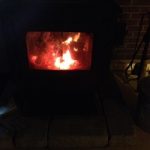
We love the cozy heat of wood burning in the woodstove.
Much of our heat at Winding Pathways comes from our two woodstoves. We love the cozy warmth given by our stoves but there’s more to it than just heat.
The wood we burn comes from trees that snatched carbon dioxide from the atmosphere in the past 100 years. Photosynthesis transformed carbon and water into wood, so we’re not contributing to global warming as much as if we burned coal, oil, or natural gas. And we get our wood free, thus helping the family budget.
Wood heat isn’t completely without cost. Each year we hire a company to clean and inspect our chimney and stove. So, we lay out some cash but far less than for conventional fuel. Wood heat also requires sweat equity to cut, stack and move firewood. At this point, it’s worth it. An added benefit is the security we feel when gazing at our six cords of stored wood. When storms shut down utilities we’ll stay warm.
Summer is an ideal time to prepare for autumn’s crisp nights.
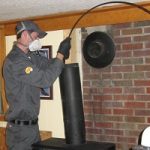
We have a professional chimney cleaner tend our chimney.In summer’s heat, we have our chimney cleaned. Chimney’s tend to accumulate build ups of a substance called creosote and soot. This build up can catch fire and ignite the entire house. Cleaning the chimney removes deposits and makes burning safer. We clean one chimney ourselves and hire a professional from Midtown Sweeps to clean a longer one that requires going up on our high roof. Chimney cleaning companies are located across the country and Midtown Sweeps has offices in many states. For information check them out. Don’t delay. As fall approaches cleaning companies get busy, so it’s best to have the chimney cleaned in the hot months of summer.
Burning the right type of wood properly yields the most heat and leads to minimal buildup of creosote. We get our wood free, and because we know how to find and choose firewood we keep cost and labor down. When choosing what wood to gather, cut, split, and burn it’s helpful to be able to identify the species of tree that the wood comes from. Every species yields a different amount of heat. Assuming the same level of seasoning, for example, a chunk of white oak yields about double the heat of a similar sized piece of basswood. By choosing high heat yielding wood labor and space needed to store wood is reduced. An outstanding way to learn relative heat value of most species of tree go to Chimney Sweep for a detailed chart. Many books and websites help with tree identification.
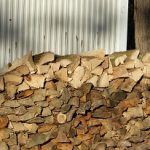
Stack wood in an airy place to cure.
To burn wood safely and hot, it needs to be cured. When we cut wood from a live, recently felled tree we split and stack it in an airy place sheltered from the rain. Place the wood up off the ground to promote air flow and reduce decay. The smaller the pieces the faster water will evaporate out of the wood. We prefer to season big chunks for 18 months but when properly stacked and split into relatively thin pieces, six months is usually adequate.
Two Scrounging tips:
- Sometimes scrounged wood is already seasoned. If the bark is off the tree and if the tree was dead and standing when it was cut down it’s likely the wood is already seasoned for burning.
- The best time for finding free firewood is during summer’s hot days when no one else is competing for firewood. The worst time to find free wood, especially seasoned wood, is during winter when competition is intense.
Winding Pathways Sources of Free Firewood
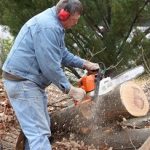
Wear protective gear when bucking up wood.
Our firewood comes from these sources that are generally available to most Americans:
YARDS. Whenever we cut or trim a tree we cut up the wood and put it in storage. Few of our neighbors burn wood and are happy to give us theirs when a tree breaks or is felled. We are also urban wood scroungers and when we find a chunk that’s fallen off a truck we collect it and add it to our woodpile. It’s surprising how much wood is available by simply being observant. After storms, home owners often drag bucked up limbs to the street edge, where they are free for the taking.
WOOD DUMP: Our city, Cedar Rapids, dumps sections of trees it has removed from streets and parks in a place they call THE WOOD DUMP. Sign a liability release form and the City welcomes anyone to remove as much wood as they’d like. It saves our town the cost of disposal and puts the wood to good use. Other cities may have similar programs. Call the town clerk or access their website for information.
SCRAP HEAP: Several nearby companies pile broken pallets and crates near their parking lot and let people scrounge wood. Mostly these are made of pine or spruce. It’s great for kindling to start fires but not for sustaining a vigorous burn. However, we sometimes find pallets made of ash, elm, or even oak. Often these include 2″x 4″ chunks, which do provide outstanding heat. We cut up pallet wood using a circular saw with a carbide blade. Use safety equipment and be careful of nails.
Get going now. Have the chimney cleaned and inspected in summer and have a shed filled with seasoned firewood before the first frosty autumn night.
Winding Pathways has no relationship, other than as a customer or user, to companies or information sources noted in this blog.
by Winding Pathways | Jul 13, 2017 | Birds, Nature
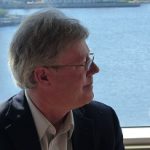
A visit with Sibley
In June, we had the delightful experience of hearing ornithologist David Allen Sibley address members of the Outdoor Writer’s Association of America. Following his talk, he chatted with us about his career, birds, and how people can best attract and enjoy birds in their yard.
Mr. Sibley is an ornithologist, artist, and writer who created the acclaimed SIBLEY GUIDE TO BIRDS, SIBLEY GUIDE TO BIRD LIFE AND BEHAVIOR, and SIBLEY GUIDE TO TREES. All are beautifully illustrated with his detailed and amazingly accurate paintings. Field guides have been around for decades and identification can become confusing because some species look slightly different in varied parts of the range. So, what makes his books so useful is the series of paintings of each species. Also, young birds often look different than their parents. To help identify them the Sibley guide shows plumage variations within a species.
The SIBLEY GUIDE TO BIRDS is designed to help identify species. It’s companion, THE SIBLEY GUIDE TO BIRD LIFE AND BEHAVIOR, provides detailed information about each species. The SIBLEY GUIDE TO TREES helps identify and learn about tree species. Additionally, Sibley has illustrated a number of other guide books and Bright Wings: An Illustrated Anthology of Poems About Birds, by Billy Collins.
In the interview, Sibley shared that birds “blur the boundary of wildness.” They come and go in our lives whereas trees are integral. “They are part of nature that is part of our lives.”
David Allen Sibley’s father was a noted ornithologist who, although he didn’t push his son to follow in his footsteps, often brought his young son on outings. “I always had a good time tagging along with my father and learned a lot by rambling about, turning over logs to see what was underneath them and just exploring,” he said. Then, he started drawing sketches of birds which he showed us. The progression of skill from black and white drawings he did as a kid to the colorful paintings as a professional is remarkable.
Sibley’s interest has evolved over the decades. Initially the excitement was the challenge of finding a bird and drawing it. The hunt, if you will. The field guides shifted his attention to the academics – how birds are similar and different. Now, with these projects completed, his attention has turned to the wondering phrase: What do birds do? How do they survive all the amazing things they do?
When we asked him, what people can do to encourage kids’ awareness of nature and make their yards a better place for a diversity of species he thoughtfully reflected. “Just provide opportunities to get the kids outside to mess around, to get comfortable being outside,” he noted. “Leaving even a small area wild, maybe the edge of a yard, will help increase habitat diversity. Encouraging brush or tall grass may attract a song sparrow that wouldn’t visit a totally mowed and clipped yard. Seeing an unusual and interesting bird in the back yard might spark a child to pursue a nature-related career or hobby,” he added.
We broached the topic of outdoor pests like ticks and mosquitoes tat so freak out urbanites. “Our risk assessment is skewed,” he stated. “It’s like shark attacks, those fears are over emphasized,” he added. The uptake is, be aware, take precautions by wearing appropriate clothing, use repellent and do a check when you return and throw clothes in the laundry.
Meeting David Allen Sibley was a thrill. We can’t imagine being without his books and were delighted to learn that as a child rambling about in nature led to his distinguished career. Most children won’t grow up to be artists or ornithologists, but a wondrous diverse and healthy back yard will inspire them to enjoy the outdoors and appreciate the amazing wild creatures that live there.
David Allen Sibley’s books are widely available online and in most bookstores. He recently has been involved in developing a new way to identify both birds and bats by sound. Called Song Sleuth, the phone app identifies bird song. A somewhat similar Echo Meter Touch bat app uses an ultrasonic microphone that picks up the echolocation of flying bats and identifies them by species.
For information check out the following:
Books: www.sibleyguides.com
Song Sleuth: www.songsleuth.com
Echo Meter Touch bat app: www.echometertouch.com
Winding Pathways has no formal affiliation with David Allen Sibley, his books, or the phone apps noted in this blog. We posted this because Mr. Sibley and his books and apps have helped us learn about the wondrous birds and trees in and around our yard.
by Winding Pathways | Jul 2, 2017 | Amphibians/Reptiles, Nature
Our blog on snakes in the yard struck a note! People loved it and some shared their “rattler” experiences. But, for most of us, snakes are helpful in the yard and we can help them, too, as these readers did. From Jackie and Peter Hull in Bedford, Virginia, a story about how they rescued a black snake.
“Several years back to protect my strawberries from birds we tucked some netting around the raised bed of strawberries which seemed like a good idea at the time. It allowed the bees and butterflies to pollinate the blossoms, but kept out critters or so we thought. One morning I was out strolling through the raised beds noting what was coming along. Much to my dismay I spotted a huge shiny black snake had become entangled in the netting. It was trying to retreat or move forward but every move just made his situation worse.
“A black snake is a godsend to gardeners and their gardens, so to have this garden friend tangled and suffering was not so good. I scurried to the house letting my husband and tough ex-Marine, Peter, know that I needed his help in the garden immediately because a black snake was in distress. I grabbed some scissors while Peter put on a long sleeved shirt, pants and leather gloves. We met by the strawberries. Peter was not in the least bit interested in untangling this creature, but I was. So I began snipping the plastic strands from around the snake’s body. Snip by snip I finally released the snake who had spent a very long time struggling to become free. He didn’t make an aggressive move so we picked him up and put him across the lane near the shrubs.
“This scenario repeated itself the following year until an idea formulated in my head. I thought: “Let’s build a screen like a window screen and place it on top of the raised bed.” We measured and ruminated about the size since we needed it to be tall enough for the plants to grow their berries. This was a complete success as the following spring we attached this contraption to the top. The bees and butterflies were able to do their work, but the birds, mice and black snake never could get in.
“The black snake is still around but not in the strawberries. Peter said he saw him a few weeks back slithering up the gravel driveway. I’m just glad he doesn’t get tangled in netting anymore.”
by Winding Pathways | Jun 29, 2017 | Mammals, Nature
A guest blog by Susan Fehsinger, New Hampshire
“I’ve spent most of my life in southern New Hampshire. Growing up, we never heard of bears being anywhere near our area, but their population has been growing rapidly. Now, we hear of them regularly. Our first live rural sighting was about 15 years ago. Since then, we either have seen them or evidence of them at least once a year.
“We live in the country on 16 acres and the nearest house is about 300 feet away across the road. There is plenty of bear habitat and they are becoming very common. Last year I was taking a walk along a class 6 road (a road that is not maintained any longer but is often used) when a black bear strolled up from the river and across the road about 30 yards ahead. I froze. S/he turned and looked at me for a long 10 or 15 seconds before continuing into the woods. Did I have my phone? Yes. Did I think to snap a photo? Nope.
“One morning this spring about 6:45, when the sky was fully light, I began to hear noises and thought our cat was running around upstairs. After a while, though, I looked out the window which opens onto our screen porch. Two bears were tearing into the stone retaining wall at its foundation. They were pulling out the seeds that the chipmunks had stored there. Both were fully grown and one of them was the largest I have ever seen in this area. The strangest part of this experience was that they didn’t spook at all. I called my husband and we both stood at the glass door taking pictures and talking.
“The population of our small town is growing, yet we are seeing more wildlife that used to be rare. I saw my first bobcat a year or so ago, also. It’s great to know that wildlife is doing well and large predators are around. We humans just need to be aware of potential danger — for us in case of a confrontation, and for them, if our behavior causes them to habituate to people. Fish and Game does not want to have to kill an animal that’s only crime is looking for food that we provide them.
“Beginning in early spring we are told to bring in bird feeders (and in my case stop using the screen porch as an extra refrigerator!) It’s definitely good advice because bears are excellent at finding any and all available food. Usually, the ones we see in early spring are females with cubs, and they can be very dangerous if a human gets between “mom” and her little ones. The fact that “my” bears were digging into a stonewall to get at seeds stored by chipmunks underlies how good they are at their job — feeding themselves and their cubs. We can learn to outsmart them, but they’ve been perfecting their food-finding skills for a long time and their senses are much better than ours. We have to become aware and vigilant so we can enjoy the fact that they’re here among us — just not too close.”
Check out these links below about
bears, habitat and behaviors. Many of these sites refer to “wild” places like parks and the North Woods. And, remember that the advice on respecting bears,
keeping your distance, and storing food all to avoid bear encounters is similar and are great tips for suburban and urban dwellers.
-
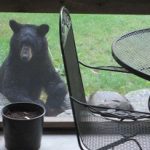
-
Bear Standing Up
-
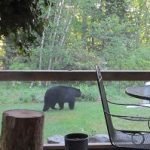
-
Bear moving off to the bird feeder.
